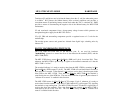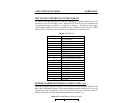
MFJ-1278B MULTI-MODE HARDWARE
MODEM DISCONNECT HEADER, J4
The modem disconnect header, J4, on the MFJ-1278B PC board is provided for using an
external modem with the MFJ-1278B. This allows use of higher-speed modems, such as
9600 baud, or more sophisticated, higher-performance modems for OSCAR or other uses.
The following information is primarily for those who wish to interface external modems to
the MFJ-1278B. Familiarity with modem and serial data channel terms is assumed. The use
of the modem disconnect header, J4 requires a definite working knowledge of modems and
serial data communications and associated terminology. A person without the required
knowledge should not do any type of modifications in the area of the modem disconnect
header, J4.
The signals used at connector J4 are at standard TTL interface levels. A TTL high, or 1, is
greater than +2.4 volts but less than +5.25 volts. A TTL low, or 0, is less than 0.8 volts but
greater than -0.4 volts. DO NOT connect an RS-232C level modem directly to J4!
NOTE: The modem disconnect is similar, but not identical to that used in TNC 1. Be very
careful about interfacing an external modem using the same cabling you may have prepared
for use with TNC 1!
For users that require pin out information on the modem disconnect header, J4, MFJ provides
the following pin out infromation. The connector pin-outs are as follows.
Pin 1 Carrier Detect Input
This pin tells the SIO radio port that a valid data carrier has been detected. It should be
pulled high when no carrier is detected and low when a carrier is present. This line must be
implemented unless the software release notes indicate otherwise. It is normally jumpered to
pin 2 when the on-board modem is used.
Pin 2 Carrier Detect Output
This pin is an output from the the on-board modem and satisfies the requirements outlined for
pin 1 above. It is normally jumpered to pin 1 when the on-board modem is used.
Pin 3 SIO Special Interrupt Input
This signal is routed to the radio port DCD input pin on SIO U21. This signal is normally
used during modem calibration. It may also be used for other purposes; if so, these functions
will be listed in the software release notes. This pin is normally jumpered to pin 4 when the
on-board modem is used.
Pin
4
SIO
Special
Interrupt
Generator
Output


















